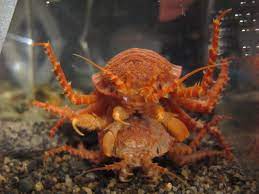The sea covers over 70% of your Earth’s work surface, with only 5Per cent than it discovered. It has generated numerous interesting findings worldwide of underwater creatures. Some of those is definitely the giant isopod, which is among the very same family members since the common woodlouse. Though they are not particularly wonderful, Giant isopods are one of the most intriguing critters located in the depths of your ocean. In this article, we will check out the intriguing field of Giant isopods and the thing that makes them stay ahead of the rest of the deeply-seas critters.
1. Giant isopods Qualities: Giant isopods are a kind of crustacean that may get older to two plus a 50 % ft lengthy and think about approximately four weight. There is a flattened, oblong-shaped body split into three specific sectors – your head, the thorax, along with the abdominal area. Their most well known attribute could be the piercing view, which rest along with stalks that allow them to see their prey or predator without transforming their heads. Giant isopods have solid, well-defined claws that enable them to crush and try to eat even the hardest of seashells.
2. Habitat: Giant isopods are found in the strong-seas, all around 1,000 to 8,000 feet below the surface area. They can be usually located near hydrothermal air vents, which offer the necessary nutrients and vitamins as germs. They are most commonly in the Atlantic, Pacific, and Indian Oceans, the location where the water is chillier, and also the strain is greater. Due to depth where they reside, very little is recognized regarding their reproduction or life routine.
3. Habits: Giant isopods are slow-moving critters that often remain invisible inside the rocks or sediment in the seafloor. They are night beings, meaning they are most active at night and have a tendency to cover up during the day. These are scavengers and feed on old wildlife that fall towards the seafloor, along with live microorganisms they capture using their strong jaws. They can reside for a long period without food and possess been proven to make it through over four years without eating.
4. Value: Although Giant isopods are not commercially important, they perform a crucial role in the sea ecosystem. They can be a vital source of food for other deeply-ocean animals, including crabs, sharks, and seafood. Their reputation indicates the fitness of deep-seas ecosystems, that could have sustained consequences on the world’s oceans and climate. Because fifty percent of your fresh air we inhale comes from the beach, it is essential to understand and shield these ecosystems and the critters that live in them.
5. Preservation: Sadly, small is known about the populace of Giant isopods, in addition to their serious-sea habitat will make it hard to examine them or their ecosystem. Global warming, strong-seas exploration, and overfishing create an important threat to such animals along with the strong-water ecosystems, helping to make shielding them even more important. For that reason, it is vital to make certain that defensive steps are set up, and endeavours are made to help save these intriguing animals and make certain they, in addition to their unique ecosystems, continue to prosper down the road.
To put it briefly
The giant isopod is really a intriguing creature that may be still becoming explored, and we have a whole lot to find out using this strong-seas being. Whilst the oceans hold many amazing things, it is important to shield the unusual, interesting, and crucial ecosystems that exist deeply below the work surface. It depends on us to shield them and make sure that they carry on and thrive for generations to come to enjoy.



